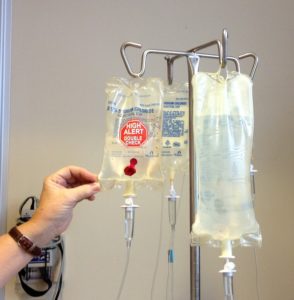 A Ph.D. student working with the Monash Warwick Alliance has made a pioneering discovery about a prospective new cancer drug. The platinum-based compound goes by the chemical name trans,trans,trans-[Pt(N3)2(OH)2(py)2], and was developed by a research group led by Professor Peter Sadler of the University of Warwick’s Department of Chemistry. It is unique among chemotherapeutic agents in that it is active only when it is exposed to light.
A Ph.D. student working with the Monash Warwick Alliance has made a pioneering discovery about a prospective new cancer drug. The platinum-based compound goes by the chemical name trans,trans,trans-[Pt(N3)2(OH)2(py)2], and was developed by a research group led by Professor Peter Sadler of the University of Warwick’s Department of Chemistry. It is unique among chemotherapeutic agents in that it is active only when it is exposed to light.
The newly created compound is completely inactive and nontoxic in the dark. Thus, it can be safely delivered to cancerous tissues, left in place, and activated at a later time with infrared light. The scientists used a technique known as infrared spectrography to observe how the compound degrades, giving them important information about how it works to destroy cancer cells.
According to Robin Vernooji, the Ph.D. student who led the study, “This is an exciting step forward…which brings us one step closer to our goal of making more selective and effective cancer treatments.”
Important Progress
Platinum-based compounds such as cisplatin and carboplatin have been a staple of cancer therapy for decades. In fact, about 50 percent of all cancer patients who undergo treatment have received or will receive at least one of these drugs.
Unfortunately, like all chemotherapeutic agents, platinum-based compounds don’t just kill cancer cells. In order to be effective, they are given in doses that damage all rapidly dividing cells, which include the cells in the gastrointestinal tract, the nervous system, the hair follicles and the bone marrow. Thus, treatment comes with a host of unpleasant side effects, including nausea and vomiting, hair loss, diarrhea and mouth sores. Additionally, suppression of the bone marrow can lead to life-threatening infections, anemia and bleeding risk. Damage to the nerves may also result in temporary blindness, hearing loss and neuropathy.

Credit: myvmc.com
Platinum-based compounds are also toxic to the kidneys, and kidney damage develops in about 20 to 30 percent of patients treated with these drugs.
But photoactivated therapy, delivered only to cancerous cells, could prevent most if not all of these effects. That’s because they don’t do any damage until they are irradiated with light. And “the light can can be directed to the tumour so avoiding unwanted damage to normal tissue,” Professor Sadler explained.
Like all novel drugs, trans,trans,trans-[Pt(N3)2(OH)2(py)2] will require further testing and clinical trials to ensure it is safe and effective before it’s available commercially. But the fact that it exists at all offers hope to millions who face the prospect of receiving platinum-based chemotherapy along with all of its attendant unpleasant effects.

 Light-Activated Platinum: A New Approach to Cancer Chemotherapy
Light-Activated Platinum: A New Approach to Cancer Chemotherapy


 The Spiritual Symbolism of Cardinals
The Spiritual Symbolism of Cardinals
 Meaning-Focused Grief Therapy: Imaginal Dialogues with the Deceased
Meaning-Focused Grief Therapy: Imaginal Dialogues with the Deceased
 Flawed Kidney Function Test Discriminated Against Black Patients
Flawed Kidney Function Test Discriminated Against Black Patients














